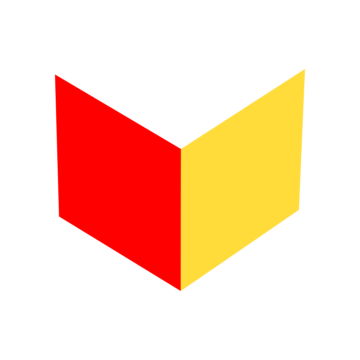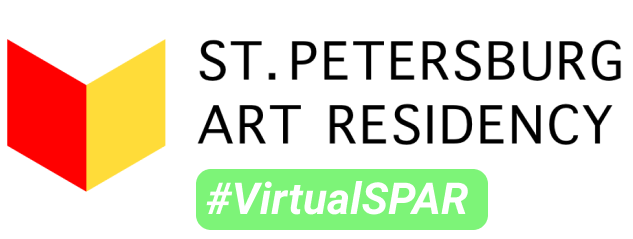On Space and Fogginess, Lack of Language and Painting. M. Jacinta Silva Armstrong, London.
Nobody watched me before, now I am watched.
The tulips turn to me, and the window behind me
Where once a day the light slowly widens and slowly thins,
And I see myself, flat, ridiculous, a cut-paper shadow
Between the eye of the sun and the eyes of the tulips,
And I have no face, I have wanted to efface myself.
The vivid tulips eat my oxygen.
Sylvia Plath
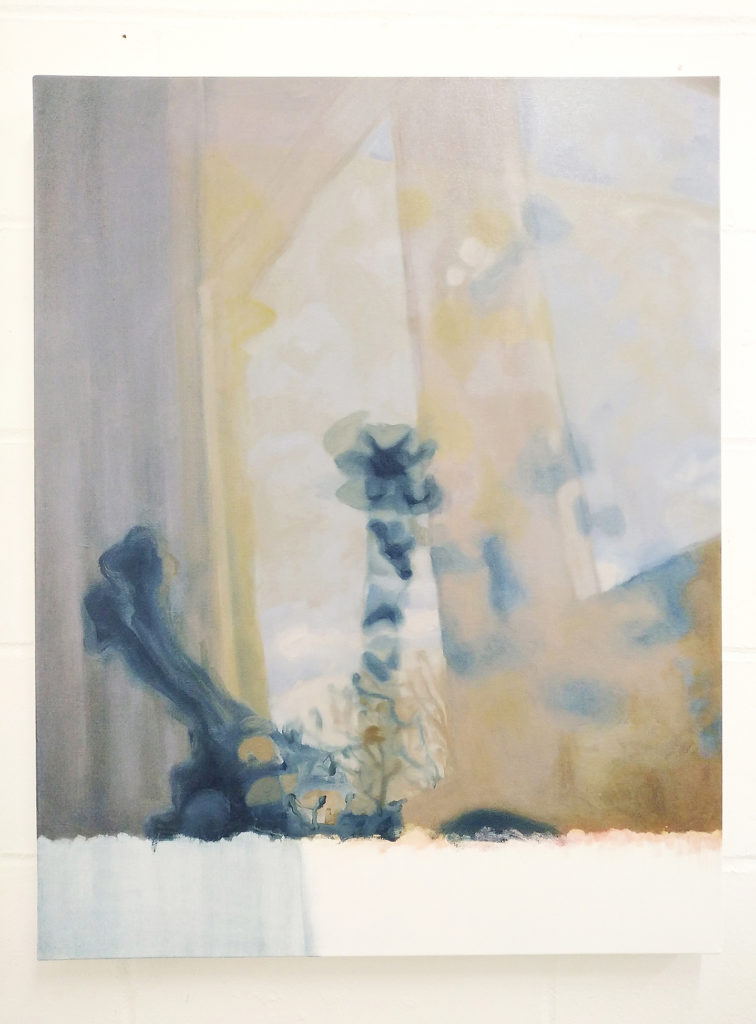
Years ago I started taking analog photographs as a personal archive. I would develop the pictures and organise them in albums, as a diary of places and people I shared with, or whatever caught my attention at a certain moment. I like the editing economy that analog processing enforces, and how afterwards I only have a few images left (opposite to the hysteric multiplication of digital captures), for a glance to a whole period.
Since the current seclusion began, I continued with this habit, yet along the way something switched. In confinement the registered findings began to be details of my house, my room or the view from my window.
A change of light,
a reflection on the window glass,
a neighbour sunbathing on their balcony.
It seems like time had extended, because I have already gathered several film rolls of these micro events – whereas before a 36 exp. film used to last for a whole year – despite the reduced space and the sensation that nothing ever happens. This archive was not conceived as an art project, but questions emerged from it that afterwards have permeated my painting practice.
I have noticed there is a type of image that repeats, and it is the kind in which some inconsistency makes the space or time within it to become ambiguous.
Interior and exterior spaces merge together reflected on a fragment of glass, nullifying each other.
My bed sheets under the half-light of dawn, resemble a moonscape-like topographic surface.
The view from my window at 4 a.m. (*before sunrise) is the same as at that of 10 p.m. (*after sunset).
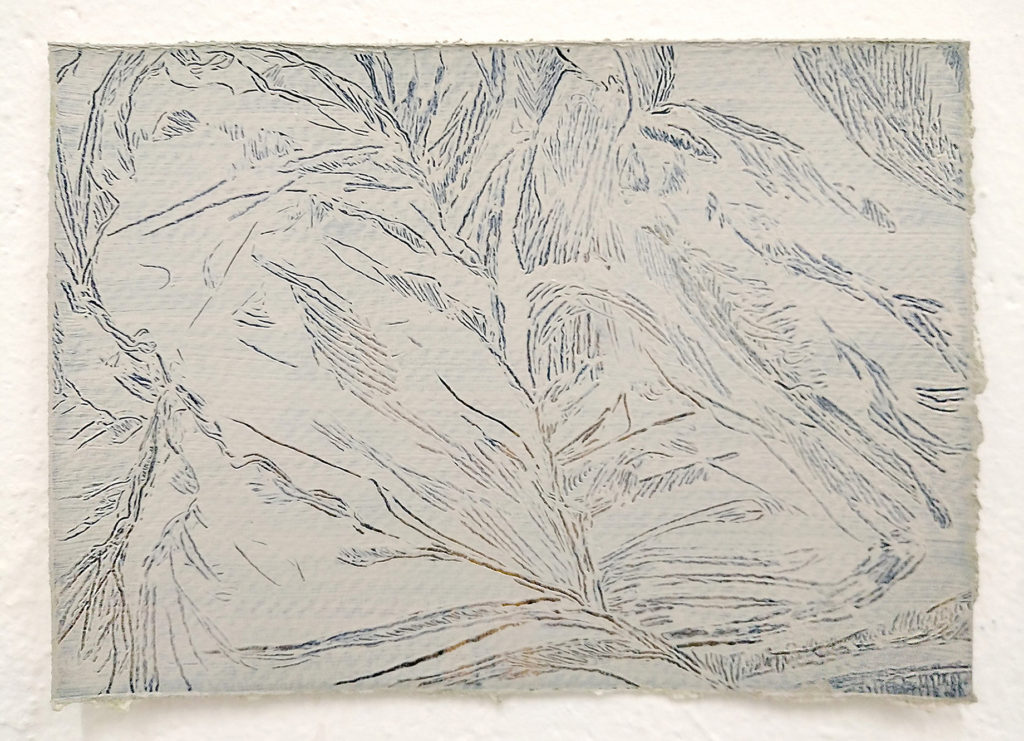
It seems to me that these images hold some truth above others. Like made of fog, they contain a confusion that feels honest, close to the moods I was experiencing at the time they were taken. Where to locate that is precisely what intrigues me and I find myself trying to unfold the uncanny in them through painting.
Scrappy fragments like a map with no references, overflowing with questions on duration and time.
The feeling of living inwards for too long.
Groundhog day, or a single long and endless one.
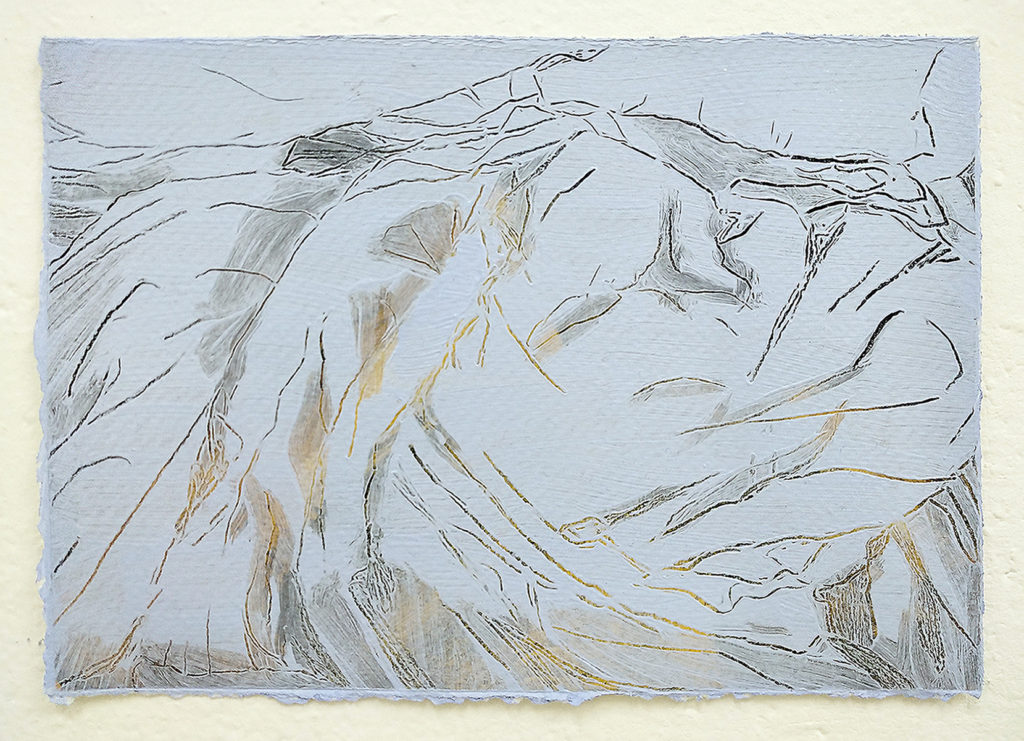
The written text is footprint and nakedness, it accuses and points out and although we can conjecture about its possible meanings, once a word is chosen it is marked on fire; it is what it is. Every word encloses a concept. Meanwhile, in the language of painting a doubt can be raised unresolved, even in a pre-verbal state. In a single gesture it is possible to hide, to insinuate, to turn ambiguous. Is that a dog or a puddle? For achieving the same vagueness in written language it is necessary to make rounds and juggle, break and disassemble, actions that in painting are done almost effortlessly with a brush stroke and a bit of cloth wiping. Any child can paint, yet poetry requires mastery.
I believe that is partly the reason why painting feels more at home to me. In the language of total insecurity, it is well allowed to throw the stone and hide the hand, leaving it to the viewer to decide what they want to read in the remainders. The insistence on hiding of an indirect speech. Figuration has always presented difficult to me, because it requires risk and certainty – unless used as a metaphor, a disguise or sign for something else.
I think that in a way we are all moved by the fear of death. We leave evidences of our existence through productions and while some fearlessly show the images that obsess them in unashamed nudity, others prefer to sketch them in an equivocal way – such as the language of politicians, born to defend itself in every case of gone wrong.
That is what the abstraction drive is to me (I would never dare to talk about what others might pursue in that language). A desire to remain, which goes hand in hand with the fear of remaining in excess. Perhaps some would speak of abstraction as an intellectual synthesis of a subject originally more complex. I prefer to think about it as an aesthetic facade for an entangled, unresolved emotionality; a lack of language, shyness to enunciate and fail, where the evidence of it may endure.
A terror of being accusable, impeachable.
The language of the poetic and non-textual word.
Urgency to raise a problem, and the cowardice to stand by it.
Makeup.
Lying blatantly so that a different truth – that I did not know was there – reveals itself unexpectedly .
Discovering that what I was painting was not what I thought, but something else that escaped me, wild and authentic, like questions from a child or drunken confessions.
A maze.
There is then the problem of space. Or rather of non-space. No shape, no words.
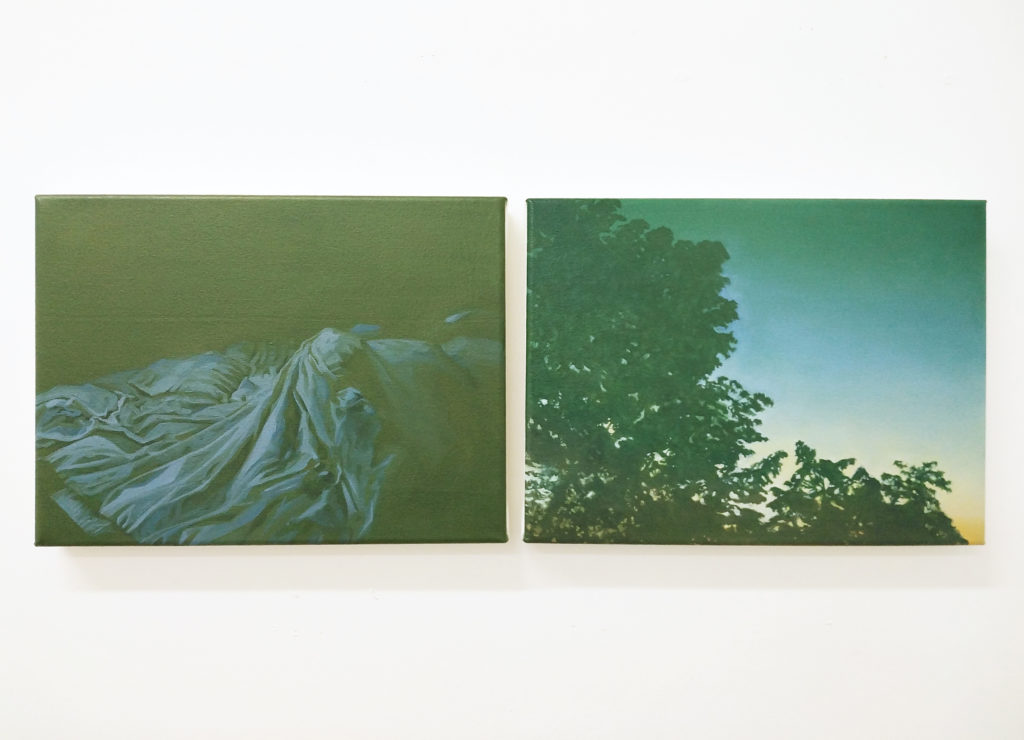
Van Luong (1)
 Kjell Zillen (4)
Kjell Zillen (4) Mels Dees (9)
Mels Dees (9) Gao Yu (4)
Gao Yu (4)Katya Lebedev (1)
Juan Dies (1)
 Anastasia Prahova (2)
Anastasia Prahova (2)Nena Nastasiya (7)
Taarn Scott (6)
 Cynthia Fusillo (20)
Cynthia Fusillo (20)Roberta Orlando (8)
 Nanda Raemansky (25)
Nanda Raemansky (25) Eliane Velozo (22)
Eliane Velozo (22)Leyya Mona Tawil (1)
Julia Dubovyk (2)
Jianglong (2)
 Iara Abreu (23)
Iara Abreu (23) Agathe Simon (1)
Agathe Simon (1)Rosetta Allan (1)
Elizaveta Ostapenko (5)
 Valentin Boiangiu (2)
Valentin Boiangiu (2) Wesley John Fourie (9)
Wesley John Fourie (9) Renato Roque (3)
Renato Roque (3)Rosa Gauditano (5)
Neerajj Mittra (34)
Ciana Fitzgerald (5)
Boris Moz (3)
 Katerina Muravuova (5)
Katerina Muravuova (5)Kyla Bernberg (1)
 Muyuan He (1)
Muyuan He (1)Liza Odinokikh (2)
 Amalia Gil-Merino (2)
Amalia Gil-Merino (2)Paulo Carvalho Ferreira (6)
 Anastasiia Komissarova (2)
Anastasiia Komissarova (2) Yumiko Ono (1)
Yumiko Ono (1) Stefania Smolkina (1)
Stefania Smolkina (1)Lena Adasheva (1)
 Zahar Al-Dabbagh (1)
Zahar Al-Dabbagh (1) Emily Orzech (6)
Emily Orzech (6) Fernanda Olivares (5)
Fernanda Olivares (5) Noor van der Brugge (3)
Noor van der Brugge (3) Ira Papadopoulou (2)
Ira Papadopoulou (2) Tom Chambers (8)
Tom Chambers (8) Titi Gutierrez (3)
Titi Gutierrez (3) Franz Wanner (2)
Franz Wanner (2) Crystal Marshall (6)
Crystal Marshall (6) Transpositions III (36)
Transpositions III (36) Riddhi Patel (3)
Riddhi Patel (3) Michele Kishita (2)
Michele Kishita (2)Damian Carlton (4)
 Deanna Sirlin (1)
Deanna Sirlin (1) Laura Salerno (3)
Laura Salerno (3) Nina Annabelle Märkl (12)
Nina Annabelle Märkl (12) Elina Fattakhova (1)
Elina Fattakhova (1) Tasha Hurley (1)
Tasha Hurley (1) Ian Hartley (2)
Ian Hartley (2) Laurence de Valmy (2)
Laurence de Valmy (2) Ilia Bouslakov (5)
Ilia Bouslakov (5) Andrea Ahuactzin Pintos (4)
Andrea Ahuactzin Pintos (4) Sveta Nosova (3)
Sveta Nosova (3)Carlos Carvalho (1)
 Maria Timofeeva (1)
Maria Timofeeva (1) Jinn Bug (2)
Jinn Bug (2) Johannes Gerard (3)
Johannes Gerard (3)Irène Mélix (1)
 Aba Lluch Dalena (3)
Aba Lluch Dalena (3) Fabian Reimann (1)
Fabian Reimann (1)Natalia Gourova (1)
 Kate Finkelstein (4)
Kate Finkelstein (4)Raina Greifer (1)
James McCann (2)
Naza del Rosal Ortiz (1)
 Jay Critchley Jay Critchley (1)
Jay Critchley Jay Critchley (1) Vicky Clarke (4)
Vicky Clarke (4) Maria Silva (4)
Maria Silva (4) Shir Cohen (5)
Shir Cohen (5) Peter Shenai (4)
Peter Shenai (4) Bo Choy (4)
Bo Choy (4)Alina Orlov (2)
 Olga Popova (3)
Olga Popova (3) Coco Spencer (2)
Coco Spencer (2) Filippo Fabbri (2)
Filippo Fabbri (2)Daniele Leonardo (5)
 SISTERS HOPE (1)
SISTERS HOPE (1) Scenocosme : Gregory Lasserre & Anais met den Ancxt (4)
Scenocosme : Gregory Lasserre & Anais met den Ancxt (4) Anne Fehres & Luke Conroy (6)
Anne Fehres & Luke Conroy (6) Olesya Ilenok (2)
Olesya Ilenok (2) Marie-Eve Levasseur (4)
Marie-Eve Levasseur (4) Natalia Tikhonova (2)
Natalia Tikhonova (2)Ildar Iakubov (1)
 Evgeniy Lukuta (7)
Evgeniy Lukuta (7) Jarkko Räsänen (5)
Jarkko Räsänen (5)Maria Guta (6)
Egle Kulbokaite Dorota Gaweda (6)
Thomas Kotik (1)
 Andrea Stanislav (3)
Andrea Stanislav (3)Ludmila Belova (1)
Alena Levina (1)
 Ilia Symphocat (2)
Ilia Symphocat (2)Yevgeniy Fiks (1)
Star Smart(Formerly Trauth) (18)
Jyoti Arvey (1)
Les Joynes (2)
 Ekaterina Ivanova (1)
Ekaterina Ivanova (1) Lev Shusharichev (1)
Lev Shusharichev (1)Michael Stebackov (5)
Ryan Griffith (3)
Lidia Gordeenko (3)
 Masha Danilovskaya (2)
Masha Danilovskaya (2)Alexander Nikolsky (1)
